Coachella 2013, Weekend One: Winners and Losers
Now in its 15th year, the Coachella Valley Music and Arts Festival is perhaps the […]
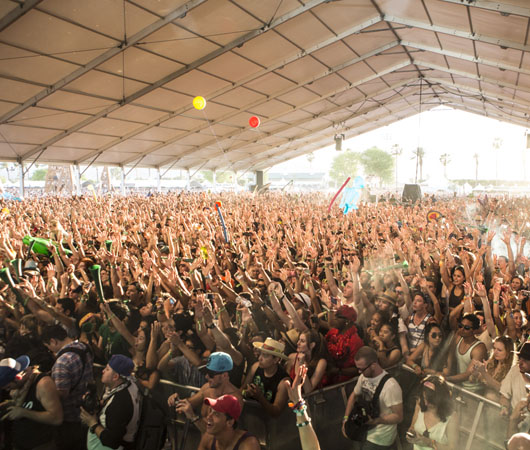
Coachella 2013, Weekend One: Winners and Losers
Now in its 15th year, the Coachella Valley Music and Arts Festival is perhaps the […]

Now in its 15th year, the Coachella Valley Music and Arts Festival is perhaps the US’ most iconic annual musical gathering. Between hosting everything from the Daft Punk performance that arguably reignited the duo’s career in 2006 to last year’s Tupac hologram stunt, Coachella has proven to be a launching point for popular and independent music while becoming a destination for music lovers with a good deal of disposable income and the ability to take a long weekend off (a.k.a. teenagers, college kids, and a certain sect of childless 30-somethings). While much of the line-up is still geared towards rock and pop, electronic music was a bigger force than ever at this year’s edition of Coachella, so XLR8R decided to make the trip down to the irrigated desert just a few hours outside of LA. After taking in three days of what the festival had to offer, we put together a list of what we saw as the opening weekend’s winners and losers.
Winner: Festival Flow
Coachella is an absolutely massive festival, one on a scale equalled by very few music events around the world. The task of making food, water, shade, parking, and—not least of all—music available for all the attendees (and of course, artists, press, staff, etc.) is certainly a tall task. Of course, running a 12-plus-hour, three-day festival with six major stages across two consecutive weekends is an even more complicated thing to accomplish. Still, after operating for more than a decade now, Coachella is a fine-tuned machine—sets run on time, food and water are always reasonably accessible, and all the staff—medical, security, sound, and video—seem to run efficiently and effectively. This may have a lot to do with why Coachella has been so successful over the years; even in the midst of hundreds of thousands of people, there are no real major inconveniences. Never do attendees need to worry about if they’ll have trouble finding a drink or if they’ll be able to find their car at the end of the night, they can just enjoy the festival (and, most likely, their drugs) with a comforting piece of mind that the festival organizers have got their back.
The crowd inside the Yuma tent (above), the Do Lab stage (below) by Glenn Jackson
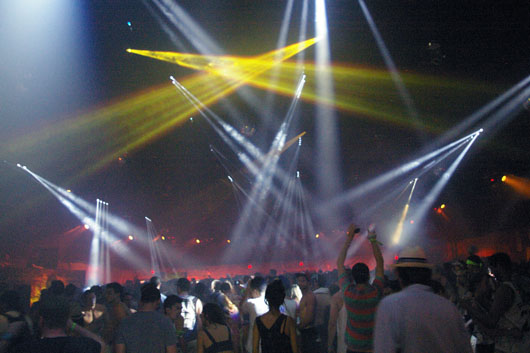
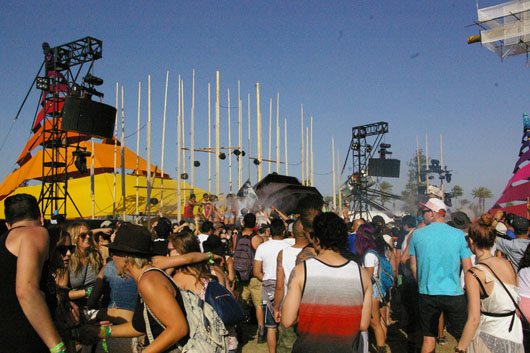
Winner: Four Tet
In the midst of a festival whose electronic offerings seemed focused on big bass drops and a fear of losing the crowd if the beat ever lost its way (yes, we’re talking about “EDM”), Four Tet‘s set in the club-atmosphere-inspired Yuma tent on Friday was already set to be a breath of fresh air before the UK producer even took the stage. Clearly, Four Tet was not afraid to lose some of Coachella’s less adventurous listeners from the start, beginning his set with over ten minutes of his trademark melodic bell sequences and washes of warm noise (eventually, a kick was snuck in underneath the proceedings, but that was still not enough to get the floor moving). The party really launched with “Jupiters,” whose arpeggiated melody gave way to the track’s massive drum pattern, its deep kick even prompting an enthusiastic “Oh!” from the crowd upon its first hit. With his live set, Four Tet displayed a patience that was absent with many of Coachella’s more brash electronic acts. His songs unfolded in a gradual fashion, building and releasing tension not in grand sweeps, but in measured steps, which helped lure the audience further in; maybe the crowd wasn’t always dancing, but it was always immersed in the music. One song in particular, a half-time endeavor led by a beautiful assemblage of wordless harmonies, seemed to work best, and Four Tet’s gentle manipulations allowed its extended run to never grow tiresome.
Winner: Dam-Funk
Los Angeles G-Funk representative Dam-Funk landed one the festival’s first successes early in the afternoon on Coachella’s opening day. Joined on the main stage by a full band—drums (with pads), an alternate keyboard player, and an exceptional bass player who utilized both keyboards and electric bass—Dam-Funk laid into his synthy grooves with a masterful ease. As a unit, Dam-Funk and his band were impressively tight, even while adding touches of live flavor, such as when the occasional gliding keyboard solo—usually at the hands of Dam-Funk’s analog synths—would take over. A boogie-indebted new cut, which Dam-Funk said was to appear on his forthcoming album for Stones Throw, and a particularly impassioned version of “Mirrors” stood out as highlights.
TNGHT by Erik Voake
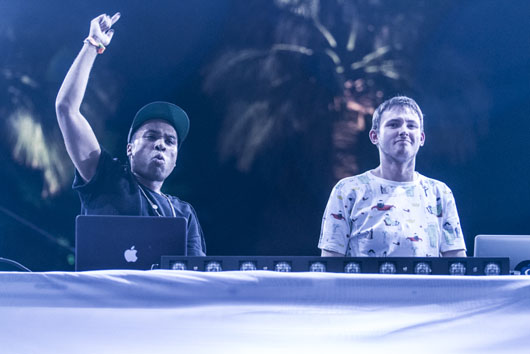
Loser: TNGHT
When Lunice and Hudson Mohawke (a.k.a. TNGHT) took to the stage just before 9 p.m. on Friday night, it seemed that everything was working in their favor. The Gobi tent, which had been only a quarter-full for the preceding act, was absolutely flooded in anticipation of TNGHT, and when the duo’s crescent-moon symbol appeared on the screens, the crowd began to explode. There was one problem though: the sound. In one of the few missteps at Coachella’s first weekend, the Gobi stage’s system simply could not carry the necessary weight to properly translate TNGHT’s bombastic music. Those standing towards the front of the stage and directly behind the second row of speakers were privy to decent sound, but everyone else (about 70% of the crowd) was not so lucky. Much of the performance landed flatter than it should have, though not necessarily by any fault of TNGHT itself. To its credit, the pair’s own productions seemed to go over best, but it was still a frustrating task to get lost in the massive 808s and sharp rhythms of the set when people could hear themselves asking, “Where’s the bass?”
Loser: Lucent Dossier Experience
Some of Coachella’s electronic acts really missed the mark. Such was the Lucent Dossier Experience, a recurring performance in Coachella’s outdoor Do Lab area throughout the weekend. Delivering six separate performances across three days, the outfit was a recurring musical low point. The performances were a bizarre combination of Burning Man-dubstep-meets-performance-art, where costumed dancers moved in coordination to the unnecessarily epic tracks played by a pair of sonic controllers—also costumed—who sat behind their respective laptops. There was singing, there was dancing, there was sonic storytelling, and—at night—there was even fire dancing, all of which made for an excessively elaborate show that was best avoided, but unfortunately hard to expunge from one’s memory.
Winner: Kenny Dope
Throughout the weekend, the Heineken Dome was set up as the “adult venue” within the Coachella festival grounds. The only 21-plus-only area with music—which was actually two enclosed and connected domes (hence the name)—fit maybe just over 200 people, and so had a more intimate feel than most other events. This all added up to make it an excellent place to catch Kenny Dope, house veteran and one-half of New York’s legendary Masters at Work crew. Presiding over three CDJs, Dope effortlessly rolled through his brand of house, hitting a peak when he began unleashing tunes lead by energetic Latin rhythms, only to bring the groove down to deeper, funkier ends as the set came to a close. Only one complaint could be found with Dope’s set: did it really have to end at 10 pm? Alas, such is Coachella.
The xx by Andrew Swartz
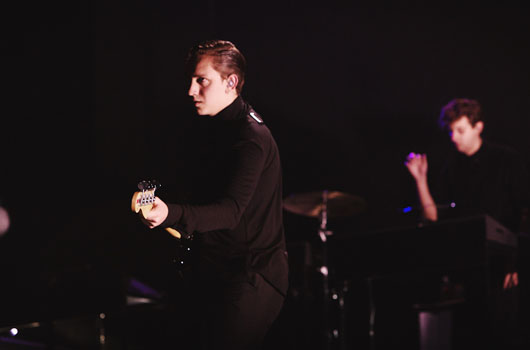
Winner: Jamie xx and the xx
Jamie xx was up against a strange set time, 3:15 p.m., when he took to the decks inside the Yuma tent on Sunday. Perhaps that explains why his set was a bit all over the map, as he jumped between remixes of The XX, chord-led UK house, Latin-inspired percussive rollers, and even some chunky techno. Still, the lack of focus did little to dissuade the anxious audience that had waited in a long line to see the young Brit spin, and even if his 75-minute set had its sputtering moments, Jamie xx still managed to deliver a prized track selection. On top of that, the night before, Jamie and his two fellow xx members brought a reserved presence to Coachella’s main stage, running through a memorable set of the group’s better-known songs, some of which were bolstered with new, more dance-friendly drums, although the set never turned into straight-up dance music. A brief rendition of Jamie xx’s “Feel Better” (which featured Jamie playing the tune’s main riff live on steel drums) was a welcome surprise; the xx’s cover of Aaliyah later in the set, not so much.
Loser: Trash
As we all know, it is a pretty simple task for humans to take an item of garbage and put it somewhere it should be, like, say, a trash bin. While proper trash and recycling receptacles were generously spread across the festival grounds, the crunch of disregarded water bottles and piles of leftover pieces of fun were impossible to avoid. The stage areas were especially bad, presumably being where onlookers had become so lost in the music as to not care where that empty water bottle, 5-Hour Energy container, mini coke baggie, or old cigarette butt landed—most people apparently decided that the ground would do just fine. The amount of trash spread across the landscape was a constant presence, and an unfortunate—and largely unnecessary—blemish on the otherwise well-maintained festival grounds.
Visuals and crowd for Simian Mobile Disco by Glenn Jackson
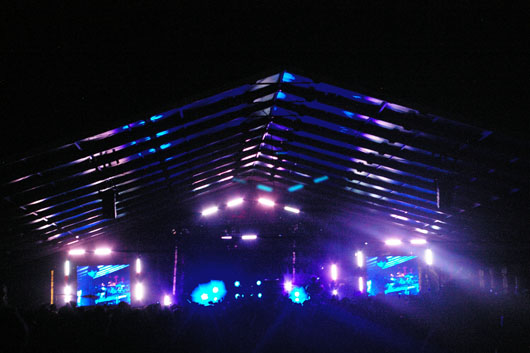
Winner: Simian Mobile Disco
While the indie kids flocked to the main stage to see The Postal Service reunite on Saturday night, at the same time a sizable crowd of dance-ready Coachella attendees made its way to the Mojave stage to hear the analog manipulations of Simian Mobile Disco. With the group’s trademark assemblage of hardware spread across two tables, the UK pair navigated a four-on-the-floor-heavy set, which unfurled pounding drum patterns topped off with melodic, constantly manipulated synth sequences. Many of the set’s offerings reworked tracks from SMD’s most recent Unpatterns LP, but the duo did occasionally dip into older fare, though—thankfully—it never ventured into the more hit-friendly territory of its electro-era output. Still, the crowd was with them from beginning to end, and the two artists’ constant movement between the many knobs, faders, and pads gave those who wished to watch the action just enough to see, while those who came to dance could probably not have cared less what was happening on stage, as long as the music didn’t stop.
Loser: The “Dance Tent”
Coachella’s Sahara tent, deemed by many to be the “Dance Tent,” was ground zero for the festival’s more brash electronic offerings—in other words, it was EDM central. Artists like Thomas Gold, Dog Blood (a.k.a. Skrillex and Boys Noize), Bassnectar, Hardwell, Eric Prydz, and many more of a similar ilk ran through sets that were chock-full of larger-than-life sonics, pop-aspiring vocal turns, and of course, so so so many “drops.” With each act we caught within the Sahara, it seemed more and more likely that some sort of rule had been imposed on all of the tent’s DJs/performers where they were not allowed to let a groove run for more than 40 seconds before jumping back into an epic build-up or a spacey breakdown. These constant, fast, and extreme fluctuations in momentum were quick to fatigue our ears and patience, and so we only saw what we did in the Sahara tent due to a kind of morbid curiosity. Still, for those attendees who were of the opinion that dance music is merely a contest to see how many times one can yell “Oh!,” the Sahara proved quite popular.
A view from inside the Sahara tent (above), and the festival grounds at night (below) by Glenn Jackson
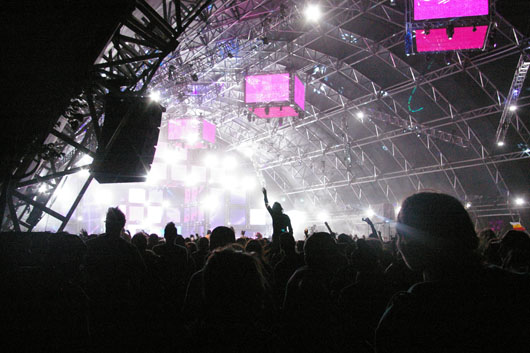
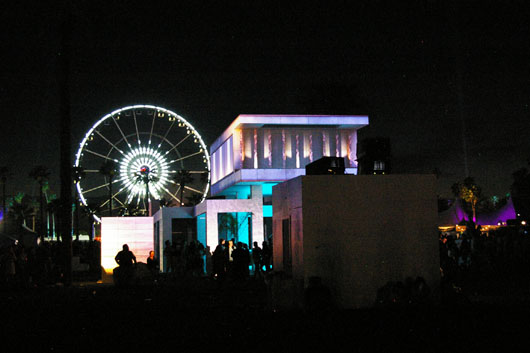
Winner: Disclosure
Disclosure may be the only outfit to go from a XLR8RBubblin’ Up feature to delivering the closing set of a Coachella weekend in just over a year. By the time the fast-rising UK duo took to the Gobi stage just after 11 p.m. on Sunday night, a sizable crowd had already gathered, one it turned out that was rather familiar with Disclosure’s work. From the instant the first kick hit, the crowd was operating on high energy—girls were on top of shoulders en masse, and the glow sticks were flying. Each brother stood behind his own station, beating out drum patterns, playing live synth lines, and—for the opening song—even singing the lyrics together. Disclosure operated on stage with a confidence that was likely built up throughout its last year of constant touring, and used the opportunity to show off a few new, unreleased tunes to the receptive crowd. Still, once the pair launched into its “hits”—”Latch,” “White Noise,” its remix of Jessie Ware’s “Running”—the party jumped to a new level. Many in the front of the audience were singing along, and a few brave souls (or just young girls high out of their mind) attempted to jump the barrier in front of the stage to get closer to the duo. Knowing where Disclosure comes from, and seeing the elation and reception the group received as Coachella’s closing act, it’s clear that the outfit’s bass/house hybrids have far outgrown the community of dance-music devotees which first garnered its growth.

